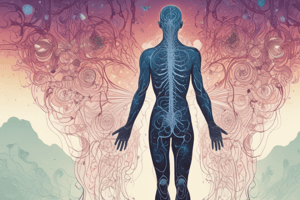Podcast
Questions and Answers
Vestibular function can be assessed by assessing a patient’s reaction to?
Vestibular function can be assessed by assessing a patient’s reaction to?
- Electroencephalography
- Needles inserted in the face
- Cold water flushed in the ear (correct)
- Facial nerve stimulation
- Needles inserted in the foot
The ironic case of Professor P makes the point that?
The ironic case of Professor P makes the point that?
- Many research methods of biopsychology are used in clinical settings (correct)
- Cortical tumors are usually malignant
- Alzheimer’s disease can have an early onset
- Brain tumors can be bilateral
- Two brains are better than one
Which technique is illustrated here?
Which technique is illustrated here?
- Positron emission tomography
- Electroencephalography
- Magnetic resonance imaging
- Cerebral angiography
- Computed tomography (correct)
Which contrast X-ray technique is designed to locate vascular abnormalities in the brains of human patients?
Which contrast X-ray technique is designed to locate vascular abnormalities in the brains of human patients?
Flashcards are hidden until you start studying
Study Notes
Research Methods in Biopsychology
- Vestibular function can be assessed through cold water flushed in the ear, a method that evaluates a patient’s reflexes and balance.
- The ironic case of Professor P emphasizes the clinical application of multiple research methods in biopsychology, demonstrating their relevance in real-world scenarios.
Visualization Techniques in Biopsychology
- Computed tomography (CT) is a significant technique used for brain imaging, revealing structural details.
- Cerebral angiography is a specific contrast X-ray technique that identifies vascular abnormalities in the brain, aiding in the diagnosis of various conditions.
Key Techniques and Their Purposes
- Electroencephalography (EEG) measures electrical activity in the brain, commonly used for diagnosing seizure disorders.
- Magnetic resonance imaging (MRI) provides detailed images of brain structures without using ionizing radiation.
- Positron emission tomography (PET) scans visualize brain function by tracking glucose metabolism, essential for studying brain activity patterns.
Chapter 5: Research Methods in Biopsychology
- Vestibular function is assessed through cold water flushed in the ear, a method that evaluates the balance system's response.
- The ironic case of Professor P emphasizes the variety of research methods used in biopsychology, particularly within clinical settings.
- Understanding the implication of diverse research techniques is crucial for students planning careers in biopsychology.
- Techniques for visualizing and stimulating the living human brain include:
- Computed Tomography (CT)
- Cerebral Angiography, which locates vascular abnormalities in the brain.
- Electroencephalography (EEG)
- Magnetic Resonance Imaging (MRI)
- Positron Emission Tomography (PET)
Key Techniques
- Computed Tomography (CT): A primary technique used for brain imaging.
- Cerebral Angiography: Specifically designed to locate vascular abnormalities in human brains.
Important Figures
- Reference to Figure 10.4 for visual illustration of cerebral angiography's application in identifying vascular issues.
- The understanding of these imaging techniques is essential for students in the biopsychological field.
Studying That Suits You
Use AI to generate personalized quizzes and flashcards to suit your learning preferences.




